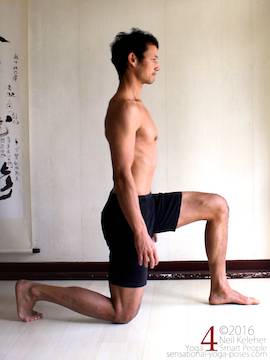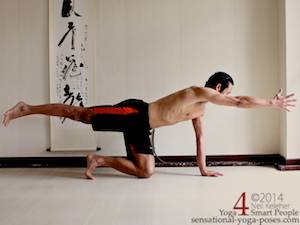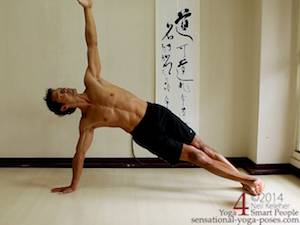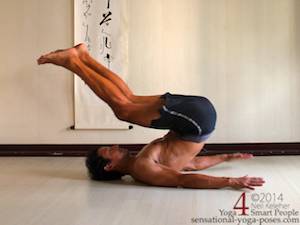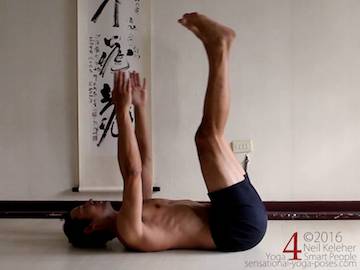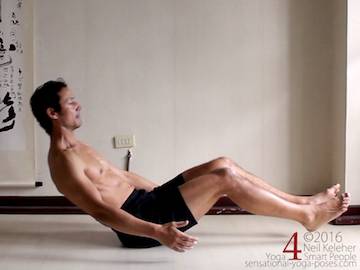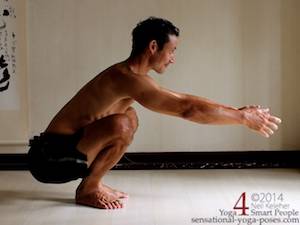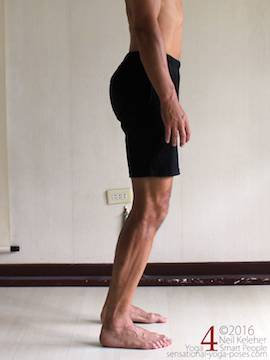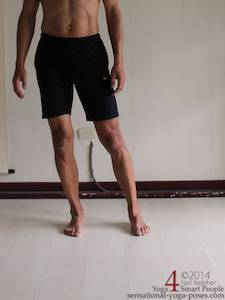Yoga poses to improve balance index
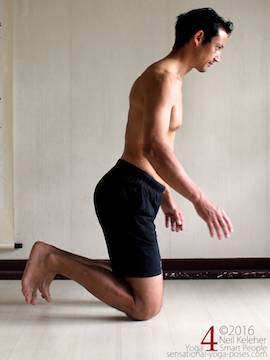
Balancing on knees
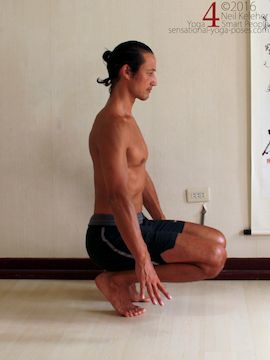
Kneeling knee lift
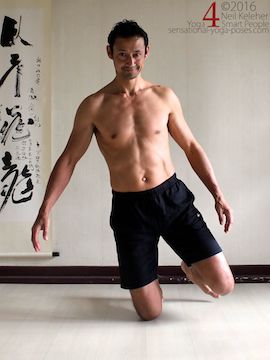
Balancing on one shin
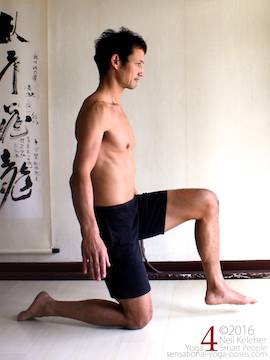
Square lunge shin balance 1
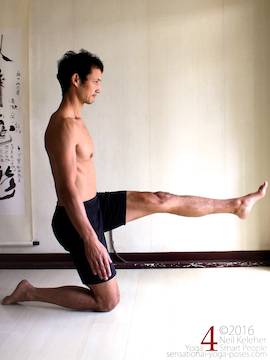
Square lunge shin balance 2
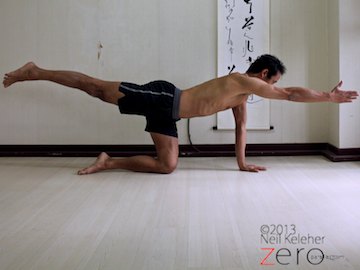
Balancing cat (bird dog)
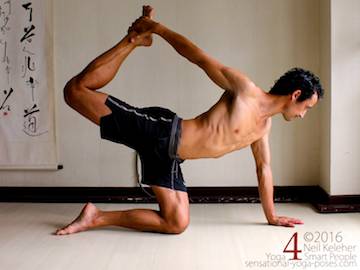
Balancing cat foot grab
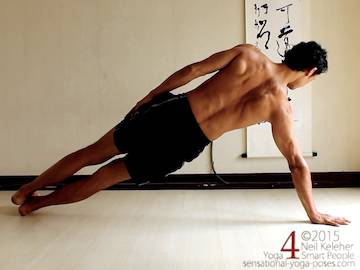
Side plank
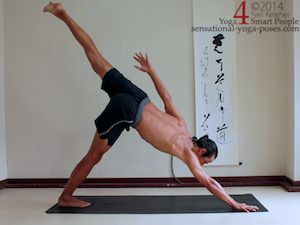
Balancing downward dog
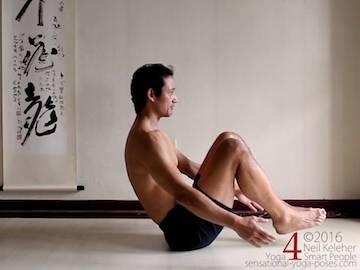
Rolling sit up
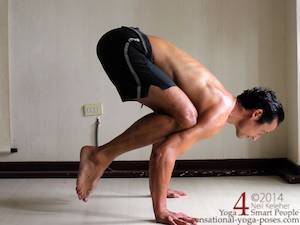
Crow pose arm balance
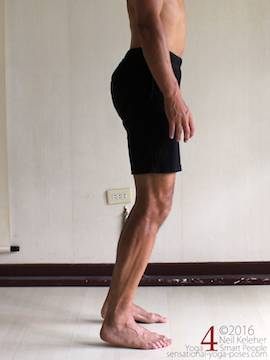
Balancing on forefeet
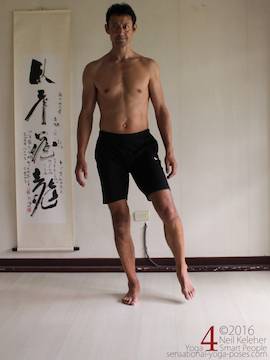
Balancing on one foot
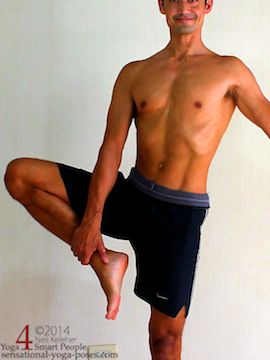
Tree pose
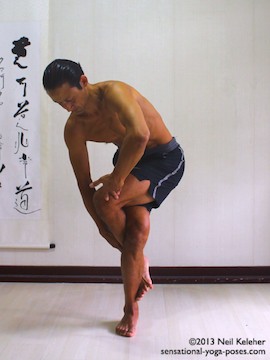
Eagle pose
More about balance
One idea about balance is that it is activity specific. I'd like to argue from the opposite point of view (particularly when learning to balance is based on feeling and controlling your body). Read more in Learning how to balance
One way to stay balanced is to focus on keeping your body as still as possible. That requires awareness. You can practice it in these mostly standing 11 Basic balance poses
For youtube videos on balance check out:
Kneeling Yoga Balance Poses
Assuming that you are comfortable kneeling, the following yoga poses include balancing on the knees, on the fronts of the feet, and then on one shin.

While kneeling shift your weight forwards so that your weight is over your knees. Shift far enough forwards that your feet lightly touch the floor. Then try to lift your feet.
While kneeling with toes tucked under, try leaning back far enough that your knees only lightly touch the floor. You may actually be upright, the important thing is that you can feel your knees only lightly touching the floor. Then try to lift your knees while staying balanced on your forefeet and toes.
For bonus points, try to lightly touch your knees back to the floor.
Improving balance can be a little more fun with the following "balancing on your shin" yoga pose.
Kneeling with your hips lifted, shift your weight to one shin and then lift the other shin. To make balancing easier you may find it helpful to shift your weight back so that you can press your toes into the floor.
You can then use your toes to help you balance.
A variation of the shin balance is balancing on one knee.
While balancing on one shin, shift your weight forwards so that you can lift your foot. You may feel like you are trying to force your knee through the floor.
A variation of this shin balancing yoga pose is to start in a square lunge.
Shift your weight back and then lift the front foot. You can also try straightening the lifted leg while staying balanced.
A variation of the shin balance exercise starts in cat pose on all fours.
Shift your hips to the left. Feel your left knee pushing down into the floor. Your right leg should feel relaxed, as if it isn't bearing weight. Lift your right leg and reach it back with the knee straight.
Next, shift your ribcage to the left. Feel your left shoulder become engaged. Your right shoulder should feel relaxed.
You can keep your right hand relaxed and lightly touching the floor. Then if you feel comfortable with your balance, try to slowly and smoothly reach your right hand forwards.
To stay balanced you can move your hand left or right whenever you feel your weight shifting or move your lifted leg left or right.
You may find Balancing Cat Pose easier if you lift the hand first and then the leg.
As with the shin balance, try pressing your foot down into the floor so that you can use your toes to help you balance. Also spread your fingers and make them strong to help you balance.
A more advanced yoga pose for improving balance is to grab the foot with the same side hand.
Rather than quickly grabbing the foot, work at doing it slowly and smoothly, in control.
Once you do grab your foot, add tension (as if to pull the hand and foot away from each other) gradually, so that it is easier to maintain your balance.
When releasing the foot, work at staying balanced. To make that easier, work at gradually reducing tension in your hand and foot prior to letting go.
By moving in and out of balance poses slowly and smoothly you can gradually improve balance.
Using side plank yoga pose to improve balance, the most important element of this pose is your bottom foot.
To make balancing easier, make your bottom foot rigid. But also try to position yourself so that the entire outer edge of the bottom foot presses evenly into the floor.
Move your hips forwards or backwards (while lifted) so that you keep even pressure on the front and back of the outer edge of the bottom foot.
Balancing in side plank and Side Plank both include progressions to make working towards side plank easier.
For downward dog you can first focus on reaching back with your hips. Then shift your ribcage to one side and lift the un-weighted hand. Then shift the hips and lift the un-weighted foot (shift ribcage and pelvis to the same side.) Keep your foot and ankle stiff to make staying balanced as easy as possible.
Rolling sit ups are another favorite balancing exercise which also exercise the abs. Round the back and roll backwards and then forwards back up to a seated position. (Use your hands if you need to, then work towards doing it without having to use your hands to help.)
Once you have the hang of it, work at doing it slowly.
Then roll all the way back onto your shoulders and then forwards onto your buttocks. This can be used as a preparation for plow yoga pose. When rolling back if you can't get your hips up and your legs back, use your hands to help. Get used to getting your weight over your shoulders so that you don't need to use your hands. To roll slowly work at keeping your center just over your point of contact with the floor, or just in front of it so that this imbalance helps you to roll.
A variation of this balance exercise starts in dead dog pose. Lying on all fours with arms and legs reaching straight up, reach your hands and legs forwards and lift your head. Then slowly sit up and while balancing on your butt. Pause and then return to the dead dog position, but slowly. Repeat a few times. (First 2 pictures below.)
Yet another rolling balance exercise is to roll back and then roll up into a squat (last picture above). This can be used as a transtion from sitting to standing. The idea is to be able to roll into a squat from a seated position. But to work towards that you may have to roll on to your shoulders first and use momentum.
This crow pose video is quite popular on youtube.
Once you can do crow pose then another yoga balance exercise is to balance on your butt, roll back slowly, then roll forwards slowly into a squat and then from there continue moving forwards into crow pose.
Then reverse the process and repeat.
Standing Poses for Improving Balance
Some standing balancing exercises for improving balance include balancing on the fronts of your feet and balancing on one foot.
Standing with feet parallel and hip width apart, shift your weight forwards till you feel your toes pressing down.
Shift forwards just enough that your toes and forefeet press down with equal pressure. Then lift your heels an inch off of the floor.
To stay balanced focus on keeping even pressure through your toes and forefeet
Another standing pose to improve balance is to Balance on one foot. Try shifting sideways to one foot. Stop when you feel your other foot relax. Make your standing foot and ankle strong so that you can lift your unweighted leg without further shifting your upper body.
If working towards improving balance in poses like tree pose or eagle pose, where one leg contacts the other, work at gradually connecting the legs.
In yoga tree pose, the foot pressing against the inner thigh changes the tension in the leg making it difficult to stay balanced. So slowly touch foot to thigh and then gradually increase pressure.
When working towards eagle yoga pose start with your top leg resting on the supporting thigh. Slowly intertwine the legs and if get to the point where you can hook your foot, do it slowly and smoothly. Once intertwined you can add tension to the legs gradually by pressing the knees and shins against each other.
For binding the arms in eagle pose read eagle pose arms.
In poses where you are grabbing a knee or foot with one or both hands, such as utthitta hasta padangusthasana and/or ardha baddha padmottanasana, gradually increase tension so that you can maintain balance.
Balance Basics
The Balance Basics ebook includes a more comprehensive and detailed look at balance theory (as it applies to yoga), along with exercises to experience balance. And it includes an optional set of videos that you can download with standing balance exercises that explain how to feel and control the feet and your center for better balance.
Published: 2015 04 27
Updated: 2021 02 09















